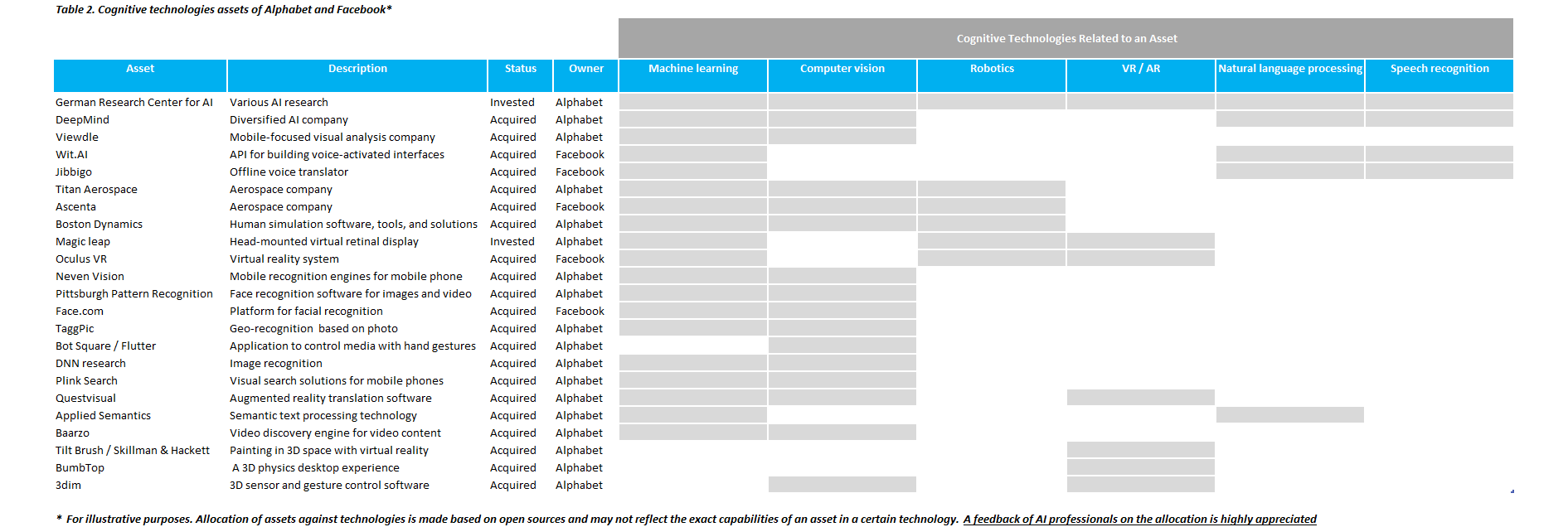What investments of Alphabet and Facebook may say about the future of the AI?
This article was originally published on Medium, and scored 189 views.
Identifying a pattern
There is an endless list of industries that the artificial intelligence (AI) may disrupt: automotive, finance, healthcare, insurance and many others are under the ‘threat’[1]. However, there is at least one industry that may find itself as close to the AI as possible.
One may suggest that advertising giants Alphabet and Facebook using their exceptional exposure to the AI may soon disrupt the industry they have previously created.
Google and Facebook combined control more that 50% of mobile advertising market[2]. Moreover, Alphabet, the parent company of Google, and Facebook have established strong positions in the AI space. According to some estimates, Alphabet’s Deep Mind team has in its staff a dozen out of fifty leading deep learning experts[3] Facebook also has increased its AI efforts[4]. Therefore, two tech giants are in a good position to develop and implement the specialized AI for the industry they rule.
History keeps at least one account of a disruption of that kind. Aerospace industry for long decades was being dominated by two or three companies (See table 1)[5]. During these several decades, the passenger airplane has evolved from a machine managed by a team of highly qualified humans to a machine predominantly managed by a computer.

The pattern was following: at the beginning of the commercial flights era, a commercial flight crew consisted of five professionals: a navigator, a radio operator, a flight engineer and a pair of pilots. ’..The radioman lost his chair during 1950s … The navigator was pushed off deck in 1960s… The flight engineer… kept his seat until the end of 1970s’[6].
Taking into account the power Alphabet and Facebook posses, transformation of advertising into an industry managed by the AI does not seem to be far ahead. Acquisitions and investments, made by tech giants, make this scenario even more viable.
Artificial intelligence assets overview
Alphabet and Facebook have acquired assets in the most important cognitive technology domains including computer vision, machine learning, natural language processing, robotics, speech recognition[7]. In addition, investments in virtual and augmented reality (VR and AR), a theme related to the AI have took place (see table 2).
Assets in VR and AR do contribute to AI development by their complex physics engines that model the real world and may be useful, for example, for teaching the AI[8].
Both companies made 21 acquisitions and 2 investments, related to the AI (or ca. 8% of all transactions mentioned by Pitchbook). The majority of acquisitions were related to diverse computer vision and recognition technologies. While remaining deals spread across robotics, machine learning and VR/AR sectors.


There is also a batch of nine investments, that lay relatively far outside cognitive technologies perimeter, but do complement it (see table 3). For instance, Behavio tracks users’ behavior via smartphone sensors and collects data that may be useful for
developing the specialized AI, say a virtual personal assistant.
Pinpointing the impact
Investments in a divers set or speech, text, gestures, image and other recognition technologies stands out of the AI-related investments of internet powerhouses. These investments may contribute to development of the specialized AI, focused on advertising market, including its creative domain.
For example, a combination of image and video recognition technologies with strong predictive models and tools for content editing may produce an AI capable of generating viral videos or illustrations. Alphabet and Facebook have acquired five companies offering video and photo processing or/and editing functions that may become a platform for development of a ‘creative AI’.
Examples of automation of creative work already do exist. Google’s arts show may be one of these examples[9]. Architecture may be another. Computer aided design (CAD) software and the technique of parametric design allow to plug-in core parameters of a building (e.g. the ratio of windows size to floor area) and receive design as an output from a machine[10].
If the pattern demonstrated by the aerospace industry will work, and an advertising/creative AI will emerge, employees of ad departments may find themselves in a position of a passenger liner crew, replacing its members by sophisticated tech.
A specialized advertising and creative AI is not the only one niche where Alphabet’s assets may be integrated. Computer vision and machine learning assets, combined with live data provided by Waze seems to enforce Google’s self-driving car project.
The current self-driving cars, according to Gary Marcus relay on very detailed pre-loaded maps and act as a ‘train on track’[11] Therefore, powerful sensors and live data, properly processed, may increase cars’ flexibility.
Considering the huge resources of Alphabet and Facebook, their position in advertising and related markets, as well the stock of AI related assets, one may expect, that these two giants may launch the wave of specialized advertising/creative AI. Success of this AI, combined with Google’s successes in unmanned vehicles may significantly push forward development of the general AI.
I would appreciate a feedback from all involved into AI research and development, especially on the matter of suggested analysis of cognitive tech assets of Alphabet and Facebook
***
[1] See for example http://singularityhub.com/2015/09/07/the-3-major-industries-ai-and-big-data-will-reshape-this-decade/ , http://www.techinsider.io/robot-ai-industries-2015-12
[2] http://blogs.wsj.com/cmo/2015/09/08/facebook-projected-to-narrow-mobile-ad-gap-with-google-as-emarketer-reverses-forecast/
[3] https://www.technologyreview.com/s/524026/is-google-cornering-the-market-on-deep-learning/
[4] https://www.technologyreview.com/s/519411/facebook-launches-advanced-ai-effort-to-find-meaning-in-your-posts/
[5]http://www.rita.dot.gov/bts/sites/rita.dot.gov.bts/files/publications/transportation_statistics_annual_report/2000/chapter7/us_aircraft_manufacturing_fig2.html
[6] ‘The Glass Cage: Where Automation is Taking Us’, Nicholas Carr
[7] See for details on the AI and cognitive technologies: http://www.theatlantic.com/sponsored/deloitte-shifts/demystifying-artificial-intelligence/257/
[8] ‘The Glass Cage: Where Automation is Taking Us’, Nicholas Carr
[9] http://blogs.wsj.com/digits/2016/02/29/googles-computers-paint-like-van-gogh-and-the-art-sells-for-thousands/
[10] ‘The Glass Cage: Where Automation is Taking Us’, Nicholas Carr
[11] ‘Gary Marcus on the Future of Artificial Intelligence and the Brain’, EconTalk Podcast, Hosted by Russ Roberts, Dec. 2014. http://www.econtalk.org/archives/2014/12/gary_marcus_on.html